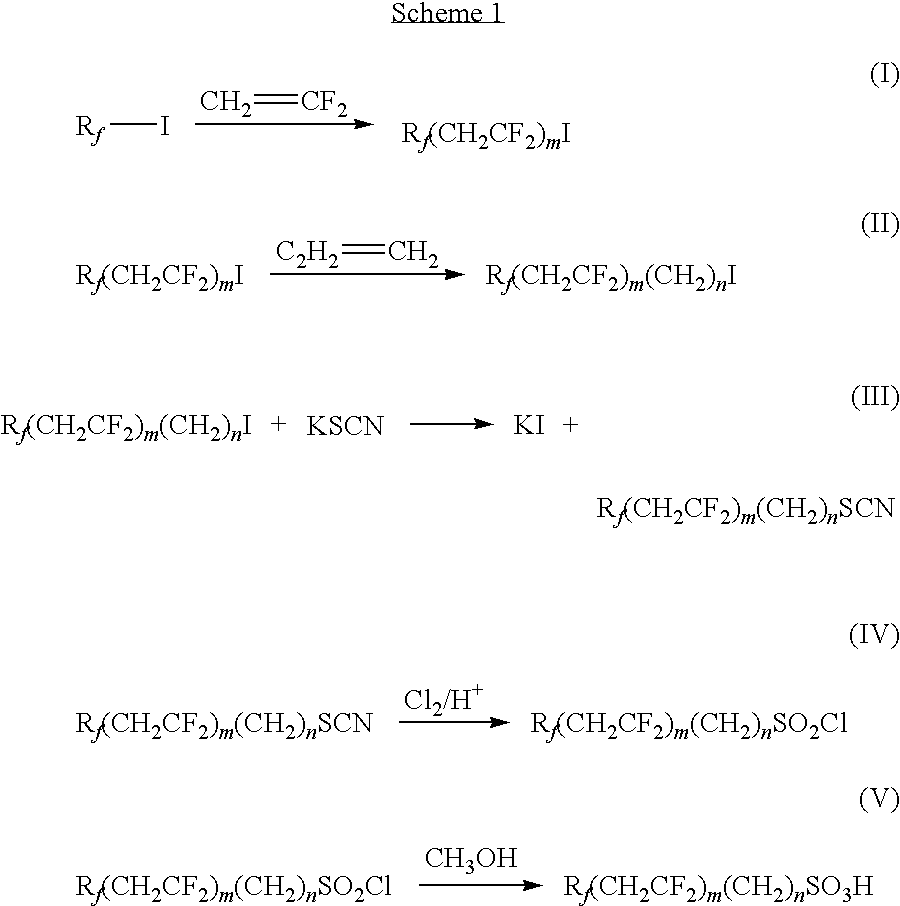Fluorosulfonates
a technology of fluoroalkyl chains and fluorinated materials, applied in the field of dispersion polymerization, can solve the problems of more expensive fluorinated materials derived from longer perfluoroalkyl chains
- Summary
- Abstract
- Description
- Claims
- Application Information
AI Technical Summary
Benefits of technology
Problems solved by technology
Method used
Image
Examples
example 1
[0069]1 L stainless reactor was charged with distilled water (450 mL), C4F9CH2CF2CH2CH2SO3Na (3.0 g), disodium hydrogen phosphate (0.4 g) and ammonium persulfate (0.4 g), followed by introducing tetrafluoroethylene (TFE) (40 g) and hexafluoropropylene (HFP) (140 g). The reactor heated at 70° C. for eight hours under agitation. The polymer emulsion unloaded from the reactor was coagulated with saturated MgSO4 aqueous solution. The polymer precipitate was collected by filtration and washed with warm water (70° C.) several times. After drying in vacuum oven (100 mmHg, 13300 Pa) at 100° C. for 24 hours, 34 g of white polymer was obtained. Tm: 249.08° C.; Composition 19F NMR (mol %): HFP / TFE (12.8 / 87.2)
example 2
[0070]A solution of 29.6 g of C4F9CH2CF2CH2CH2SO3Na, 18.5 g disodium phosphate heptahydrate and 24,900 g of deionized, deoxygenated water was charged to a 40 liter reactor. The solution was heated to 80° C. After removal of trace oxygen, the reactor was pressurized with 2441 grams of a mixture of 4.2% by weight vinylidene fluoride (VF2), 85.8% by weight hexafluoropropene (HFP), and 10.0% by weight tetrafluoroethylene (TFE). At the end of pressurization, the reactor pressure was 2.0 MPa. The reactor was charged with 50.0 ml of an initiator solution of 1% ammonium persulfate and 5% disodium phosphate heptahydrate to start polymerization. As the reactor pressure dropped, a mixture of 35.0% by weight vinylidene fluoride, 37.0% by weight hexafluoropropene, and 28.0% by weight tetrafluoroethylene was fed to the reactor to maintain a 2.0 MPa pressure. After 45 g of this monomer mixture had been fed, 26.0 g of a mixture of 37.29 mol % 1,4-diiodoperfluorobutane, 46.38 mol % 1,6-diiodoperfluo...
example 3
[0071]The Compound 2 which was made by the procedure described above was used in the surface tension measurement according to the Test Method 1. The results are shown in Table 1.
PUM
| Property | Measurement | Unit |
|---|---|---|
| particle size distribution | aaaaa | aaaaa |
| feed pressure | aaaaa | aaaaa |
| feed pressure | aaaaa | aaaaa |
Abstract
Description
Claims
Application Information
 Login to View More
Login to View More - R&D
- Intellectual Property
- Life Sciences
- Materials
- Tech Scout
- Unparalleled Data Quality
- Higher Quality Content
- 60% Fewer Hallucinations
Browse by: Latest US Patents, China's latest patents, Technical Efficacy Thesaurus, Application Domain, Technology Topic, Popular Technical Reports.
© 2025 PatSnap. All rights reserved.Legal|Privacy policy|Modern Slavery Act Transparency Statement|Sitemap|About US| Contact US: help@patsnap.com

